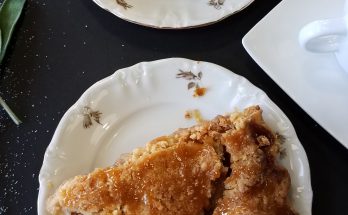Few holidays are as tradition-filled as Christmas. But, despite knowing what “traditional” foods are, few Americans have ever tasted a sugarplum, much less wassail or a mincemeat pie. In honor of The Nutcracker’s dancing delicacies, here are a few recipes you and your family can add to holiday menus.
Sugarplums
What are they? Sugarplums are dried, sugared plums. They became popular in the 1500s, when sugar first became affordable and accessible to many and was used to preserve summer fruits. Sugarplums were popular Twelfth Night gifts, especially during the Victorian era, when The Nutcracker ballet, with its Sugarplum Fairy, debuted.
Traditional recipe:
1 lb. plums
Several pounds of white sugar
Water
Cover the bottom of a large pot, preferably enamel, with sugar. Wash and cut plums in half; remove the pits, but do not peel. Line the bottom of the pot with plums, cut-side down. Cover that layer completely with sugar before adding another layer of plums. Repeat until all layers are in the pot and covered with sugar.
Over the lowest heat possible, gently melt the sugar, stirring occasionally so the sugar doesn’t burn or stick, but trying not to agitate the fruit. When all sugar is dissolved, increase the heat and allow mixture to boil for one minute. Remove pot from heat. Remove fruit with a slotted spoon and place in a large glass or ceramic bowl, cover the fruit with the liquid and gently top with a small plate to keep fruit submerged. Let marinate for three days at room temperature. If pot is enamel, the fruit may stay in it for the same amount of time. To keep ants away, place the pot or bowl in a larger container with a few inches of water at the bottom.
After three days, gently remove fruit and bring the liquid to a gentle boil (be careful not to burn the sugar). Return fruit to the liquid and boil for one minute. Remove from heat and allow fruit to soak for another three days. Repeat until fruit has been soaked and boiled for a cycle of nine days.
After the last soaking, remove fruit from syrup. Heat syrup to a boil, adding one additional cup of sugar. Boil the syrup until it thickens. Then, add fruit and gently boil for four minutes. Remove pan from heat. Gently remove fruit with a slotted spoon. One at time, rinse the plums under cool water and peel, if desired.
If you’re patient, spread the plums (with or without skins) on a wire rack in a warm, dry place and turn the plums every other day until dry (could take anywhere from a few days to two weeks). If you’re less patient, separate plums on parchment paper and bake at 170 degrees, turning every half-hour until dry. Before they dry completely, roll in crystal sugar. To store, keep in a cardboard box between waxed sheets of paper. Plums will last for up to a year, getting chewier, but no less tasty, with age.
Modern version:
Toast almonds and finely chop. Mix the almonds with finely chopped dried fruits, such as apricots and/or dates. Mix in enough honey to coat and add cinnamon, allspice and nutmeg to taste. Form little balls out of the mixture and roll in powdered sugar. Refrigerate on waxed paper in an airtight container overnight before serving. They will keep for a month. Or, visit a local gourmet shop; many sell sugarplums during the holiday season.
Wassail
What is it? Wassail is a hot, spiced punch dating back to the Middle Ages. Originally, the punch was made of beer. Today, many people equate wassail with spiced wine or mulled cider – heated drinks that pre-date wassail and are more closely related to the Roman-era winter beverage called “calda.”
Traditional recipe:
6-pack of hearty ale
Sugar, ginger, nutmeg and cinnamon to taste
Toast
Heat the ale in a large pot, adding sugar and spices to taste. Top with slices of toast.
Modern version:
For a no-heat version, pick up a six-pack of any microbrewery’s spiced beer, available during the winter months. Or, combine 2 quarts apple cider with 1 cup each of orange, lemon and pineapple juice. Heat over stove, adding 3 sticks of cinnamon, 2 tsp. whole cloves and 2/3 cup sugar. Warm for at least an hour before serving. Leftover mulled cider may be frozen for future use.
Mincemeat pie
What is it? Mincemeat is a mixture of shredded meat, dried fruit, spices and a liberal amount of brandy, rum or whiskey. It was developed as a way of preserving meat without salting or smoking, and appeared most often in mincemeat pies. These traditional Christmas treats were banned in England after Oliver Cromwell abolished Christmas on Dec. 22, 1657. They made a big comeback when King Charles II restored Christmas in 1660 everywhere but in Boston, Mass., where they continued to be a fineable offense until 1681.
Traditional recipe:
Pastry recipe (for pie crust and lid) :
2 2/3 cups all-purpose flour
1 tsp. salt
1 tsp. sugar
16 tbsp. butter, cubed
3 to 6 tbsp. ice water
Mix the dry ingredients. Cut in butter in a food processor or with two knives, mixing until coarse. Add just enough water to make the dough sticky. Flour hands and separate dough into two balls. Wrap in plastic and refrigerate at least one hour before rolling into two large discs.
Grandma Myers’ mincemeat filling:
4 lbs. venison, elk or beef
2 ½ cups finely chopped suet
7 ½ cups chopped tart apples
3 cups liquid from cooking meat
5 cups sugar
3 cups apple cider
1 cup molasses
½ cup apple cider vinegar
3 cups raisins
2 tbsp. each, ground cinnamon, ground allspice and ground nutmeg
1 tbsp. of ground cloves
Juice of 2 lemons and 2 oranges
1 cup brandy or sherry
Trim fat from meat and simmer over heat until meat is tender. Refrigerate overnight in cooking juices. Skim fat from the top and reserve liquid. Discard bones and chop meat into small cubes. In a large pot, combine all ingredients except liquor and simmer for 2 hours. Remove from heat and add brandy or sherry to taste. Refrigerate or can leftovers.
Assembling the pie:
Preheat oven to 425 degrees. Spoon prepared mincemeat into pastry-lined pie shell. Add brandy to taste and cover with remaining pastry. Seal crust and cut slits to allow steam to escape. Cover edge with aluminum foil to prevent excessive browning and bake for 40 to 50 minutes until crust is golden brown. Serve warm.
Note: Dough also may be used to create individual-sized pies. Just spoon a tablespoon or two of mincemeat onto a circle of dough. Fold dough in half, pinch crust to seal, cut vents to allow steam to escape and bake on a greased cookie sheet until crust is golden brown.
Modern version:
One of the more interesting, and difficult to find, ingredients of mincemeat is suet, better known as raw beef or mutton fat. For this reason, it’s far more convenient to buy prepared mincemeat from a gourmet or English-imports shop (many of which also carry vegetarian versions). Spoon the contents of a 28 oz. jar into a pastry-lined pie shell, add crust and bake as directed.
The Nutcracker also features dancing candy canes and gingerbread, treats that are easy to find in supermarkets. Here are some simple recipes if you want to try making these Christmas classics from scratch:
Candy canes
1 cup sugar
¼ cup light corn syrup
¼ cup water
1/8 tsp. cream of tartar
4 drops oil of peppermint
4 drops red or green food coloring
Mix sugar with corn syrup, water and cream of tartar, simmering until the mixture can be gently cracked. Remove from heat and add flavoring. Divide the syrup in half, adding food coloring to one batch, keeping one batch white. Pour out syrup on separate, greased surfaces and cool for a couple of minutes. Roll each section into 1/2-inch-thick ropes. Twist the two ropes together until they stick, trimming into 6-inch sections. Shape as desired and allow to cool.
Old-fashioned gingerbread
1/3 cup sugar
½ cup melted butter
1 egg
1 cup molasses
2 cups all-purpose flour
1 tsp. baking soda
1 tsp. salt
1 tsp. ground cinnamon
1 ½ tsp. ground ginger
1/2 tsp. each ground cloves and salt
½ cup buttermilk or sour milk
1/4 cup hot water
To make a gingerbread house, trim wall and roof shapes from rolled dough, baking on a greased cookie sheet. Assemble on a sheet of cardboard, “gluing” walls and roof together with melted chocolate. Use white frosting to create “snow” and affix sugary treats or gingerbread people and animals to the house’s roof and yard. Melted and poured sugar can be used to create windows. Small cookies or biscuits can be used as window shades or doors. Other fun additions include plastic toys, colored icing trim and edible snowmen. The houses keep for at least two weeks (wrap with cellophane and an attractive bow to keep fresh) and kids love “destroying” (read: eating) them after festivities are over.
Preheat oven to 350 degrees; grease and flour an 8-inch square pan. In a large bowl, mix the wet ingredients until consistency is creamy. Sift the dry ingredients together in another bowl, then fold into the wet mixture. Beat in hot water. Pour mixture into greased pan. Bake for 40-50 minutes or until a knife comes out clean. Serve with whipped cream or lemon sauce.
To make gingerbread people, roll dough on floured or greased surface and use a cookie cutter to trim shapes. Bake 30-40 minutes on a greased cookie sheet. Decorate with raisins, small candies or frosting.
Roasted chestnuts
Preheat oven to 425 degrees. Slash an X on the flat side of each chestnut and bake on a cookie sheet for 15 to 25 minutes. Wrapping the hot chestnuts in an old towel and squeezing helps release the shells and makes peeling easier. If the nuts cool to where shells are difficult to remove, reheat briefly.
Sources: About.com, godecookery.com, whatscookingamerica.com, wikipedia.com



